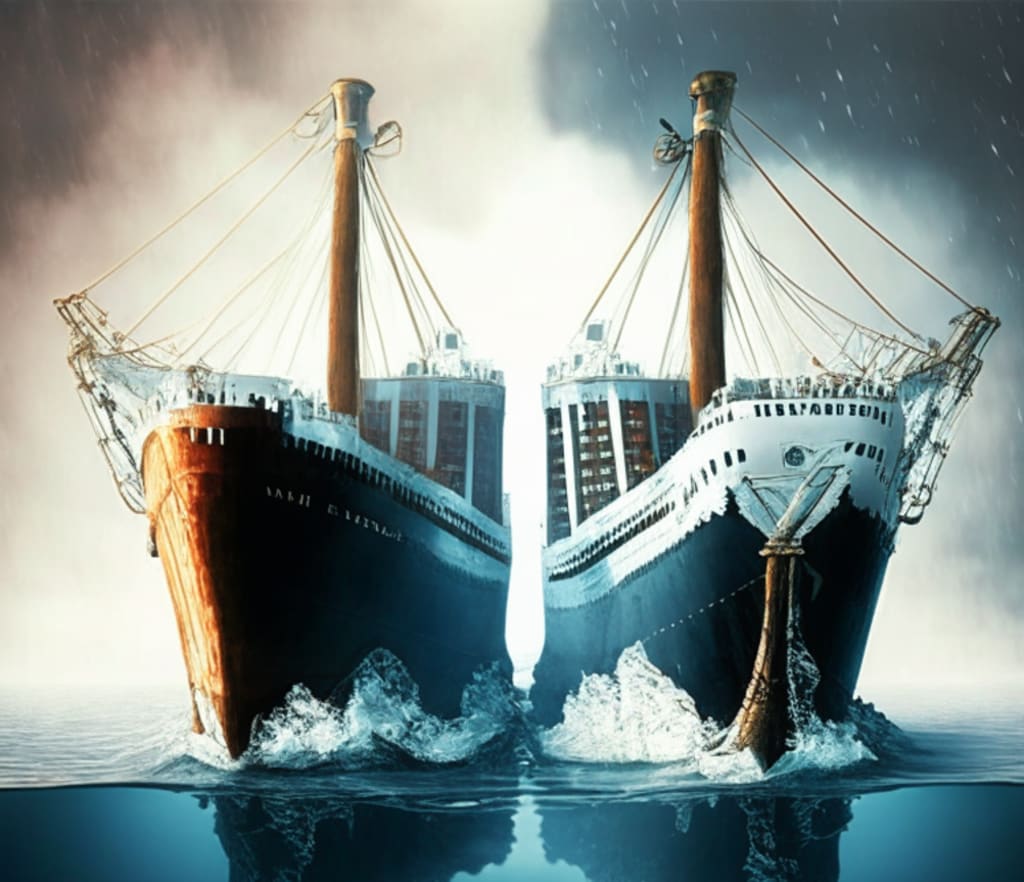
Many people know the story of the Titanic, but few know that it had two sister ships. On the night of its sinking, one of them was rushing to help but didn't make it in time. Bad luck seems to follow those involved in this tragedy. Each ship had glorious moments that live on in the memories of those who sailed in them.
People were certain that the Titanic would not sink because of how large it was. Nobody could have foreseen what happened- the iceberg hit the ship, the band played to the end, and then the tragedy unfolded. The company that built the Titanic- White Star Line- had high hopes for what their unsinkable ships could do. The first of these three ships, the Olympic, sailed to New York on June 11th, 1911.
The Olympic's maiden voyage went smoothly and a crowd of 8000 people in New York got to explore its luxurious accommodations while it was docked there were high expectations for the massive ship but just around two months later it crashed with the HMS Hawk. The hawk got the brunt of the damage as the bow was left flat as a pancake after the crash, but the Olympic made its way slowly back to Belfast where the Titanic was being constructed on the dock. Parts of the Titanic were used to put the Olympic back in shape, a rare sight to behold.
The Titanic collided with an iceberg. Shortly after, the crew sent distress signals to nearby ships, seeking help. On that same night, the Olympic, which was returning from New York, received the distress signal. Without hesitation, the ship altered its course and raced back to the Titanic at full speed. However, due to the considerable distance between them, the Olympic would have reached the Titanic on the following night, sometime in the early hours of April 15, 1912. Realizing that they wouldn't arrive in time, the crew of the Olympic made the difficult decision to stop their course. Eventually, the survivors of the Titanic were rescued by the Carpathia. It's worth noting that the Olympic had lifeboats available for all crew members and passengers.
After the sinking of the Titanic, significant modifications were implemented. The number of lifeboats was increased from 20 to 64, ensuring better safety measures. Additionally, changes were made to the watertight bulkheads, and an extra hull was installed to create a double-hull configuration. It was believed that this double-hull design would have prevented the Titanic from sinking for several years.
During the war against Germany, the Olympic played a crucial role. Over several years, the ship carried more than 200,000 passengers, including numerous Americans escaping from Europe and troops engaged in World War One. A noteworthy event in the ship's history was when it collided with a German submarine, causing it to sink. It was discovered that the submarine had been preparing to launch a torpedo at the Olympic before the ship rammed into it.
The Olympic sailed for 30 years and earned the nickname "Old Reliable." It helped the survivors of HMS Audacious and did what its sister ship, Titanic, couldn't. Unfortunately, bad luck struck the Olympic when it crashed into the Nantucket lightship. This marked the beginning of its decline. After years of service, the beaten-up Olympic was demolished and scrapped. It served many passengers, but its journey ended. On the other hand, Britannica's service was shorter-lived as it sank with the Titanic.
White Star Line faced a problem because they were already building another huge ship. Construction of the HMHS Britannic began on November 30th, 1911, around four months before the Titanic sank. Although the Britannic was the youngest among the three ships, it was also the largest. Originally, they planned to name it "Gigantic," but after the Titanic disaster, they changed the name to Britannic, considering it a lucky name.
After the sinking of the Titanic, White Star Line underwent a thorough investigation, leading to numerous changes in the design of the Britannic. The Britannic closely resembled the Titanic and featured the world's largest marine turbine at that time, allowing it to achieve faster speeds than the Olympics.
With the memory of the Titanic's tragedy fresh in their minds, every possible measure was taken to ensure the safety of the newer ship. The Britannic was finally launched on February 26, 1914, almost two years after the Titanic's demise. The White Star Line aimed for the Britannic to restore its reputation following the disaster of the Titanic.
The Britannic started to thrive as a successful ship, transporting passengers for over a year and a half. However, during the early stages of World War One, the British government requisitioned the Britannic and transformed it into a hospital ship. The ship's appearance became even more impressive, painted entirely in white with large red crosses on its sides to signify its role as a hospital ship. One of the ship's surgeons, Dr. J. Th. Beaumont regarded it as the most incredible hospital ship to have ever sailed the seas. It could treat up to 3,309 patients at once.
The Britannic became His Majesty's hospital ship, HMHS Britannic, and though it brought smiles to wounded soldiers, its time as a hospital ship was short-lived. While on its way to pick up wounded soldiers in the Aegean Sea, the Britannic was hit by a loud explosion, causing confusion among the passengers who gathered on the deck to disembark. It is uncertain what caused the explosion, but the prevailing belief is that it struck a mine left by a German U-Boat, while some still argue it was hit by a torpedo. The captain attempted to steer the ship towards a nearby beach, but it was sinking rapidly. Against the captain's orders, several crew members launched lifeboats, only to have them destroyed by the propellers due to the ship's movement. Despite efforts to make the Britannic safer than the Titanic, the explosion left it in a similarly dire condition.
In a cruel twist of fate, the Britannic also sank into the ocean, but unlike the Titanic's high death toll, only 30 people perished, with over 1,000 survivors. The accident occurred in the morning when the water temperature was warmer, and the Greek island of Chao was nearby to assist, resulting in many people surviving. The Britannic's sailing time was just over two and a half years. Remarkably, Violet Jessup, a crew member, and nurse, sailed on all three ships, surviving the Olympic's collision with the HMS Hawk in 1911 and later escaping the sinking Titanic in Lifeboat number 16, showing women it was safe to board lifeboats. One would imagine this would be enough to keep her from ever getting on a boat again.
Years later, Violet served as a nurse on the Britannic when it was a hospital ship, and during the explosion, she jumped overboard, got pulled under by the water, and hit her head on the keel, yet miraculously survived, reflecting her incredible resilience; overall, the trio of ships experienced both triumph and tragedy, with ill-fate trailing behind, but the survivors were left with incredible stories to share.
About the Creator
V.U.D
A deep love for history and an insatiable thirst for facts.
Join me on this journey as we uncover the hidden gems of our shared history.
This page serves as a tribute to the remarkable tales that shaped our world.
You'll love it here!






Comments
There are no comments for this story
Be the first to respond and start the conversation.